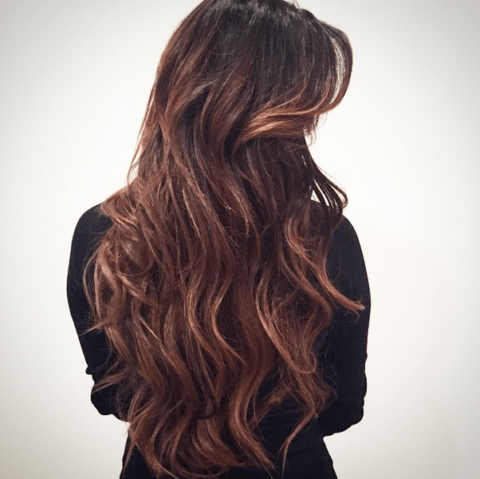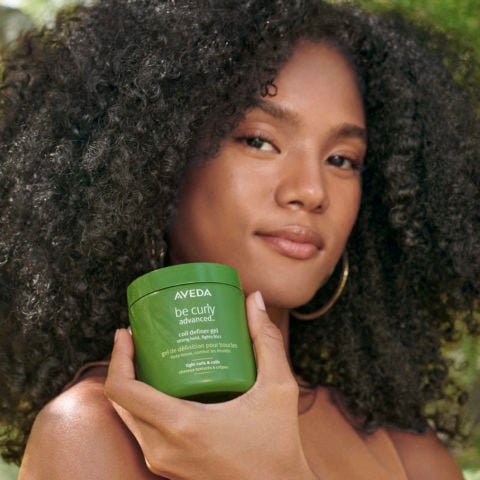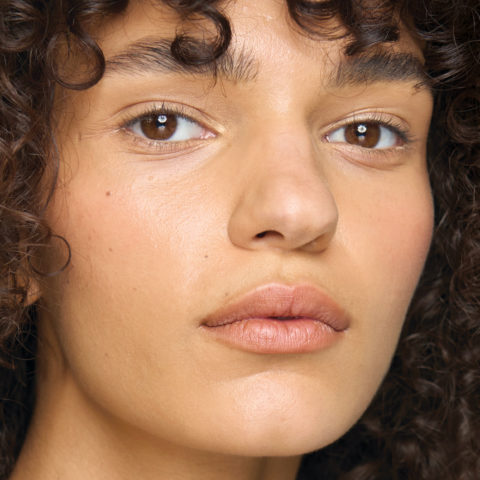Hair extensions are back! Your complete guide to longer strands + why they don’t deserve their bad rap

Hair today, gone tomorrow! In the time it takes to perfect your contouring technique or get your eyelash extensions redone, you can dramatically alter the inches of your strands. And while the thought of hair extensions can often bring back memories of Nicole Richie circa The Simple Life era, they have advanced significantly. There’s certainly reason to get nervous when you think about gluing, taping, bonding, braiding, beading or clipping real human hair to your head, but if done well you can take any haircut into luscious locks territory.
And since we’d rather pay for immediate results instead of sitting and slathering miracle lengthening potions on a nightly basis, we’re about to usher your hair into unchartered terrain. From blow dry bars that can offer sophisticated styles in less than half an hour, there’s a new breed of extensions bars popping up boasting promises of split second lengthening options. It is now a cinch to successfully cheat the process and pretend you’re packing some extra inches sans the sizeable damage from extensions’ past.
When it comes to deciphering and decoding your Rapunzel waves, there are lots of methods to explore. From discerning the difference between synthetic versus real, to the practices in place, the process can feel overwhelming, to say the least. So in order to get your desired length and lift, we touched based with celebrity extension wizard Pricilla Valles, whose roster boasts Christina Aguilera, Chrissy Teigen and Kylie Jenner. We also talked to Toronto’s Locks & Mane for their take on hair extensions.
Before you buy
As we said, there are plenty of avenues to examine, including your natural hair’s strength. While long flowing waves would be the envy of your water cooler social circle, if your own scalp can’t stand up the pressure, you’re looking at more loss than gain. So prior to arranging an appointment at your nearest and dearest extension bar, familiarize yourself with what’s at stake. Valles notes that we must always “make sure our extensionist is certified with whatever method they are selling you.” Not matter how shiny or sparkly the salon, the added pressure, if done incorrectly could be a recipe for disaster. Additionally, understand that there are several textures, shades and methods to appoint, and each salon will eagerly claim the top prize. So before you take the plunge, visit about three salons for a host of opinions and prices.
Consultations are key
Once you feel confident in your extensionist and their method, you can now proceed to matching the colour and talking length. If you’re not after knee-grazing length, and you’d prefer to go with just a subtle lift, make your extensionist is aware. Furthermore, do some research on the hair that you’re purchasing. While synthetic hair will come at a bargain basement price, you are getting what you pay for. These strands won’t hold up to heat styling and will get tangled with a greater ease. And while beauty technology is improving by the minute, the quality of the hair is nowhere near the quality of the more expensive human hair alternative. Most sophisticated salons and certified extensionists will steer clear from synthetic hair altogether, so just keep that in mind when you book your next appointment.
Do your homework
New methods of installing extensions crop up all too often, but fusion, tape-in and micro beads are the front-runners for those looking to lengthen their locks with minimal harm done. Buyers beware, none of these techniques are in any way “good” for you, as there’s a risk in every ritual you’re signing up for. “Damage can be caused by an inexperienced extensionist, so do your research. It’s very important to have someone certified. I can’t stress that enough,” says Valles. “Extensions have a bad reputation and we need to change that. Also, it’s your responsibility to never keep your extensions in longer then two to three months.” And in order to do so, ensure that the weight of extensions doesn’t put additional stress on your roots. It’s critical that that your extensionist examine the texture of your hair and is realistic about what it can handle. Finer hair should opt for a lighter density and so forth. The placement is also fundamental, and should only be adhered to where the hair is the strongest.
Micro beads
Jennifer and Vanja of Toronto’s Locks & Mane have their method of affordable and safe extensions down to a science. By only using 100% human hair, and having an arsenal of shades at the ready, you can sit in their Parisian-inspired salon for under an hour, and spend less than you would on microdermabrasion. The method doesn’t involve any heat, chemicals or glue and can last up to eight weeks depending on the texture of your hair and the upkeep. And for only $195-$235 depending on the length, the risk and commitment involved are pretty minimal. Furthermore, in between the duration of your extensions, L&M offers a tightening service that can ensure your extensions lasts another 4-6 weeks, and offer a mid-procedure pop-in to ensure your locks are cooperating as planned. And because it’s such an entry-level price point, this booming extension bar has noticed that 75% of their cliental are new to extensions. After trying and testing out this method, we can only conclude that it is relatively risk free and your hair is in good hands. Simply put, without the use of heat, bonding or sewing, your strands can breathe and hopefully grow healthier underneath your existing extensions.
Tape-Ins
This relatively new technique on the beauty block involves just double-sided transparent tape and your scalp. This is a feasible option for women looking for instant results, as the commitment level and price are barely there. Additionally, this technique stays put for one to three months, and is entirely dependent on the upkeep, as well as how quickly your hair grows. “This method is easy, as it only takes about 30 minutes to apply, and you can reuse the hair at least 3 times or more,” adds Valles. So for those looking to create some viable beach waves, as well as to avoid adhering extensions to their thin strands, this process is perfect.
Clip-Ins
This option is fitting for those looking to take chances with their looks. “Every girl needs a set of clip in extensions!” says Valles. “There are so many out there, but I recommend that you have your stylist put them in and give them a nice cut to blend them in with your own hair. Always have your stylist cut any type of extension with a razor and not scissors.” So once you’ve tracked down ‘the ones,’ take your existing strands and your newfound friends and head straight to the salon for a clip-in 101 class.
Sew-Ins
Sew in extensions or weaves are most often worked into coarse or thick strands, so if this doesn’t apply to you then rule this one out. The procedure entails having braids sewn into the underside of your hair, and then the extensions are sewn onto those braids using a thread. This technique could feel a bit painful for those who are sensitive to tugging, and can take hours from start to finish. Valles explains, “I’m not the biggest fan of sew-ins, and I personally have no clients with in sew-in extensions. I feel like they don’t allow your scalp to breath and they are not as comfortable.” And although this technique can certainly be affordable, only strands that are very thick can stand up to this added weight and pressure.
Bonded
This technique has an atrocious reputation due to one too many botched jobs. This finicky procedure requires a very skilled technician, and since it’s the most preferred and popular method, salons are popping up boasting the service without certification. And while this is a great method for those looking for added volume and length without having to endure a head full of braids or beads, it’s arguably the most expensive option out there. Additionally, another method to this keratin-tipped technique is the micro-ring method, which differentiates itself by removing heat from the process. The extensions are applied to the shaft with small rings that are clamped, and will prove to be a viable option for those who are combating years of heat damage already. “The individual keratin bond is my specialty and my favourite method,” says Valles, “because they are the most custom of all. They are attached with a keratin plastic bond (about the size of a grain of rice) and attached to the strands, which also come in a wide range of colours. With keratin bonds you can basically build a wig, as you can easy put 300 bonds in someone’s head. You can create a blended beautiful colour, while creating your own pattern. And by adding lowlights, highlights or ombré, you can completely change the color and add length at the same time without bleach. And the biggest extension trend right now is adding lighter longer hair to dark hair which can be accomplished using this method or the tape-in technique.” So if you’re looking for a realistic length, while experimenting with colour, this solution is for you.
Keeping up with your locks
The upkeep of hair extensions is not as simple as brushing with a wide-tooth comb, notably because you’re dealing with your natural hair growth underneath. Visit your extension bar in between the prescribed time for quick glance. This is a great way for a professional to comb through your mane, and check for warning signs. If you can already tell that the extensions are beginning to feel looser, or that your hair is looking less than flattering, it might be time to trade up or take them out. And in between your long locks, just remember that your scalp craves fresh air. Just as you (hopefully) take breaks in between your gel manicures and eyelash extensions, the hair on your head requires the same downtime.
Priscilla adds that “to take care of extensions, you should use a brush specifically designed to keep your extensions detangled. Use a really good conditioning mask and never apply styling heat to the bonding method. Always stay about two inches away from any bonding, and it also helps to sleep in braids.” Moreover, if you’ve invested in human hair extensions, they should blend with your existing hair with the assistance of your hairdresser. The most effective way to keep your extensions undetectable is by investing in a quality chop afterwards. A word to the wise, avoid bleach at all costs and treat your extensions as you would your natural hair. Take extra care when wet, avoid heat styling and hold the hair at the roots when detangling from the bottom. Keep any hair oils at bay, and always, always use a wide-tooth comb.
What to expect upon removal
When you’re back in that salon chair, and you’re gazing down at your fake locks falling to the floor, expect that your natural strands will come out, too. Your hair naturally sheds as you brush and wash it, and with extensions, you’re essentially glazing over this step. If you note a great deal of your own hair loss on the floor, this could be a warning sign that your extensionist was inexperienced, or your hair couldn’t handle the additional weight. While the most unrivaled hair helpers will go out of their way to protect against damage as much as possible, your strands are susceptible to breakage no matter what.







